Causation of Defects in Concrete Floors
Just like "clothes make the man", quality concrete floors represent the structures in which they are placed, be it homes, offices, hospitals or warehouses. A cracked or scaled floor is hard to disguise and is indicative of bad workmanship and probably a weak structure. It is the first thing the eye notices, the first impression made of the structure by anyone walking through. Corrective actions are always expensive because removing the hardened concrete is a noisy, dusty operation, especially when conducted during normal working hours. This is because noise and dust that result from removing the damaged concrete must be sequestered.
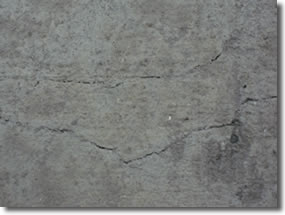 Judicious placement of contraction joints Judicious placement of contraction jointscan minimize these shrinkage cracks |
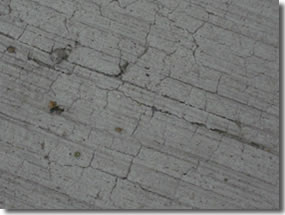 Crazing
cracks from a paste rich surface Crazing
cracks from a paste rich surfacewhich underwent delayed curing |
Who is to blame? Everyone involved in placing the concrete is called on the carpet by the owner. It may be the architect who specified the concrete mix design, the concrete mix plant, the contractor who placed the concrete and the laboratory that monitored the quality just prior to placement.
Sometimes, attempts are made to cover up the defects by placing a terrazzo layer. Unfortunately, the terrazzo cover reflects the defects of the underlying surface. Where cracks appear in the concrete, cracks will show in the terrazzo. In time, the terrazzo cracks propagate and become more visible as the crack widen and fill with dust and dirt. If the surface of the concrete is dusty, the terrazzo soon separates from the surface and breaks under pedestrian and vehicular pressure.
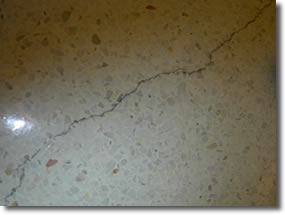 The cracked terrazzo was installed The cracked terrazzo was installedover a cracked concrete base |
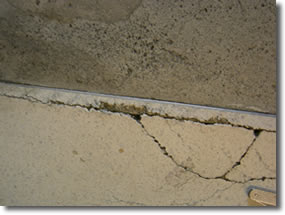 Lack of a vapor barrier Lack of a vapor barrier caused the terrazzo to crack |
Simply described, concrete is an aggregate of crushed stone and sand cemented with water and Portland cement. The quality of the hardened concrete depends, to a major extent, on the quality of the aggregate, sand and water and the timing of placement. Because cement is manufactured by reputable kiln operators, large corporations operating under very high standards of quality control, the quality of the cement is never questioned.
Concrete can be modified with additives such as fly ash and blast furnace slag that impart special properties. The contractor may not modify the concrete mix design. The design of the concrete, usually determined by the architect, must be sufficiently sturdy to support the structural loads. This means that the contractor must not dilute the concrete with an excess of water or sand. The cement, the glue that binds the aggregate, functions best if placed within 90 minutes of mixing. Also, after placement (casting), there are prescribed operations that must take place within rigid time limits and under controlled environments. It is up to the contractor to adhere to these operational boundaries if the concrete surface is to be free of defects.
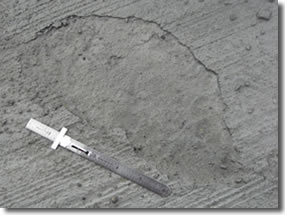 Delayed hard trowel finishing of the surface Delayed hard trowel finishing of the surfaceof freshly placed pavement takes place because the bleed-water is entrapped below the thin hard surface paste |
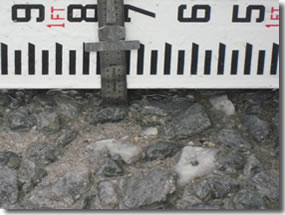 Over-hydration
by a water stream Over-hydration
by a water streamcaused this washout of cement paste, exposing coarse aggregate |
A qualified petrographer examining solidified concrete can identify deviations in the concrete mix design and point out the causes for failures such as cracking, scaling, pop-out of aggregate, dusting and crazing of pavements and floor surfaces.